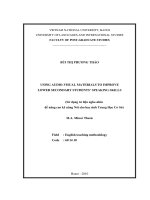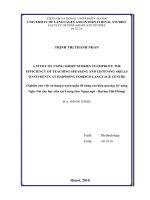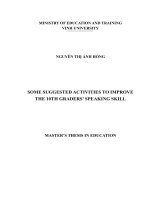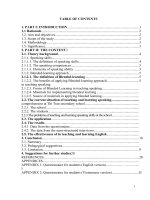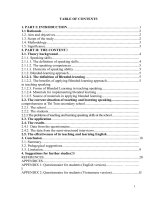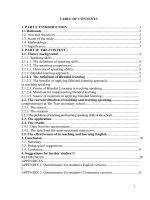Using Discussion Activities to Improve the EFL Students’ Speaking Skills At Dong Nai Technology University (DNTU)
Bạn đang xem bản rút gọn của tài liệu. Xem và tải ngay bản đầy đủ của tài liệu tại đây (498.98 KB, 100 trang )
VIETNAM ACADEMY OF SOCIAL SCIENCES
GRADUATE ACADEMY OF SOCIAL SCIENCES
Lê Thị Hạnh
USING DISCUSSION ACTIVITIES TO IMPROVE
THE EFL STUDENTS’ SPEAKING SKILLS AT
DONG NAI TECHNOLOGY UNIVERSITY
MA THESIS IN ENGLISH LANGUAGE
HANOI, 2019
VIETNAM ACADEMY OF SOCIAL SCIENCES
GRADUATE ACADEMY OF SOCIAL SCIENCES
Lê Thị Hạnh
USING DISCUSSION ACTIVITIES TO IMPROVE
THE EFL STUDENTS’ SPEAKING SKILLS AT
DONG NAI TECHNOLOGY UNIVERSITY
Field: English Language
Code: 8220201
Supervisor: Bùi Thị Thục Quyên, Ph.D.
HANOI, 2019
DECLARATION BY AUTHOR
I, Lê Thị Hạnh, certify that the thesis “Using Discussion Activities to
Improve the EFL Students’ speaking skills at Dong Nai Technology University”
is entirely my own work, in my own words and I am the sole author of this
thesis. All sources used in researching it are fully acknowledged and all
quotations properly identified. I confirm that this thesis has not been submitted
for any other degrees.
The research reported in this thesis was approved by Graduate Academy
of Social Sciences.
Author’s Signature
Lê Thị Hạnh
Approved by
SUPERVISOR
Bùi Thị Thục Quyên, Ph.D.
Date:……………………
1
ACKNOWLEDGEMENTS
Although only one name appears as the author of this work, writing a
thesis is indeed a collaborative effort. I would like to express my sincere thanks
to the many people who made it possible.
First of all, I would like to express my heartfelt gratitude to my M.A.
thesis’s supervisor, Bùi Thị Thục Quyên, Ph.D. for all of her encouragement,
timely guidance and useful comments.
I would like to convey my sincere appreciation and thanks to Mr. Đặng
Nguyên Giang, Ph.D. and the staff of the Department of Foreign Languages,
Graduate Academy of Social Sciences for granting me the honor of writing this
thesis as well as their assistance and most valuable supports.
I also would like to express my colleague and my students to help me with
valuable data for the study.
Finally, I would like to express my gratitude to my beloved family and
friends who always support me during the progress of conducting and finishing
this thesis.
TABLE OF CONTENTS
DECLARATION BY AUTHOR
ACKNOWLEDGEMENTS
ABSTRACT
LISTS OF FIGURES
LISTS OF TABLES
LISTS OF ABBREVIATION USED IN THE THESIS
CHAPTER 1: INTRODUCTION
1.1. Rationale
1.2. Aims of the study
1.3. Research questions
1.4. Significance of the study
1.5. Scope of the study
1.6. Research methods
1.7. Structure of the study
CHAPTER 2: LITERATURE REVIEW
2.1. Speaking skill
2.1.1 Definition of speaking
2.1.2 The importance of speaking
2.1.2. Problems with speaking activity
2.2. Characteristics of a successful speaking activity
2.3. Discussion
2.3.1. Definition of discussion
2.3.2. Types of discussion activities
2.3.2.1. Brainstorming activities
2.3.2.2. Organizing activities
2.3.2.3.Compounding
Activities
2.4. Asse
ssing
speak
ing
skill
Page i
ii vi vii viii ix 1
1
1
2
2
2
3
3
4
4
4
5
6
7
9
9
9
10
11
12
14
2.4.1. Oral tests
14
2.4.2. Speaking proficiency testing criteria
14
2.5. Motivation
19
2.5.1. Definitions
19
2.5.2. Types of motivation in language learning
20
2.5.3. Factors affecting motivation in foreign language learning
21
2.6. Previous research
22
2.7. Chapter summary
24
CHAPTER 3: METHODOLOGY
25
3.1. Research design
25
3.2. Setting and subjects of the study
26
3.3. Research procedures
28
3.3.1. Step 1: Preliminary investigation
30
3.3.2. Step 2: Planning
30
3.3.3. Step 3: Implementing the action
31
3.3.4. Step 4: Observation
31
3.3.5. Step 5: Reflection
31
3.4. Data collection instruments
32
3.4.1. Survey questionnaires
32
3.4.2. Class observation
33
3.4.3. Oral tests
33
3.5. Data analysis
34
3.6. Chapter summary
35
CHAPTER 4: FINDINGS AND DISCUSSIONS
36
4.1. Survey questionnaire 1: Student’s motivation in learning English
36
speaking lessons
4.1.1. Levels of interest in English speaking lessons and discussion
36
activities
4.1.2. Students’ speaking opportunity
37
4.1.3. Students' difficulties in learning speaking English
38
4.1.4. Students' preferences for types of discussion activities
38
4.2. Survey questionnaire 2: Student’s attitude toward discussion
40
activities after implementation the action
4.2.1. Level of interest in learning speaking lessons
40
4.2.2. Students' attitude in speaking lessons
41
4.3. Class Observation Findings
42
4.4. Students' speaking proficiency
45
4.4.1. Results of Pre-test
45
4.4.2. Results of Post-test 1
47
4.4.3. Results of Post-test 2
50
4.5. Reflection
53
4.5.1. Reflection after Cycle 1
53
4.5.1. Reflection after Cycle 1
54
4.4. Chapter summary
56
CHAPTER 5: CONCLUSION
57
5.1. Recapitulation
57
5.2 Concluding Remarks
58
5.3. Implication
58
5.4. Limitations
59
5.5. Suggestions for Further Studies
60
REFERENCES
61
Appendix 1: Survey questionnaires
I
Appendix 2: Class observation sheet
IX
Appendix 3: Oral tests
XI
Appendix 4: Speaking band descriptors
XIV
Appendix 5: Lesson plans
XIX
ABSTRACT
The study was written based on the research done by the writer as a teacher
at Dong Nai Technology University. The study was carried out by using
discussion activities with two aims. They are: (1) to investigate the EFL
students’ attitudes towards discussion activities in their speaking classes and (2)
to evaluate the effectiveness of discussion activities applied to English speaking
skill teaching and learning.
The subjects participating in the research were 25 students (Elementary
Level) from many Faculties of Dong Nai Technology University. To achieve the
desired aims of the study, action research was used as the method to carry out
the study.
Classroom observation and survey questionnaires were used to measure the
students' motivation level before and after the implementation. Besides, to
clearly see the change in students' speaking proficiency after applying
discussion activities in speaking lessons, oral tests were also used as a data
collection technique.
The results of the study show that discussion activities helped increase most
of the students’ motivation in speaking lessons. In addition, the findings of the
study also reveal that after using discussion activities in speaking lessons, some
of the students could improve their scores in the post-test. Although there was
not too much change, it was proved that discussion activities played a certain
role in improving the students' speaking proficiency.
LISTS OF FIGURES
Figure 3.1. Kemmis and McTaggart's action research spiral
28
Figure 4.1. Students' levels of interest in English speaking lessons
38
and discussion activities
Figure 4.2. Students' difficulties in learning speaking English
40
Figure 4.3. Students' preferences for types of discussion activities
41
LISTS OF TABLES
Table 2.1. Students' oral evaluation criteria
15
Table 2.2.a. Oral Proficiency Scoring Categories Grammar
16
Table 2.2.b. Oral Proficiency Scoring Categories Vocabulary
17
Table 2.2.c. Oral Proficiency Scoring Categories Comprehension
17
Table 2.2.d. Oral Proficiency Scoring Categories Fluency
18
Table 2.2.e. Oral Proficiency Scoring Categories Pronunciation
18
Table 2.2.f. Oral Proficiency Scoring Categories Task
19
Table 3.1. The schedule of the action implementation
32
Table 4.1. Students’ speaking opportunities during speaking lessons
39
Table 4.2. Students' level of interest in learning speaking lessons
42
Table 4.3. Students' feelings in speaking lessons
43
Table 4.5 Overall class motivation scores for all students
45
Table 4.6. Results of Pre-test
48
Table 4.6.a. General Results of Pre-test
48
Table 4.6.b Results of students' speaking performance in the pre-test
49
Table 4.7. Results of Post-test 1
51
Table 4.7.a. Overall mark of Post-test 1
51
Table 4.7.b. Results of students' speaking performance in the post-test 1
52
Table 4.8. Results of Post-test 2
54
Table 4.8.a. Overall mark of Post-test 2
55
Table 4.8.b. Results of students' speaking performance in the post-test 1
55
LISTS OF ABBREVIATION USED IN THE THESIS
EFL: English as a Foreign Language
DNTU: Dong Nai Technology University
CHAPTER 1: INTRODUCTION
1.1. Rationale
It is clear that speaking is one of the most important skills among
other foreign language skills (listening, speaking, reading, and writing). Even
when learners are good at vocabulary, grammar or listening they still cannot
speak well. With the mission “to become an applied university, to train quality
human resources in order to meet the needs of socio-economic development
and international integration” (from www.dntu.edu.vn), English is one of
priority subjects at Dong Nai Technology University.
As a teacher at Dong Nai Technology University, I found that speaking is
so hard for non-native English Foreign Language students. The teacher also
noticed that they did not know how speak English well and they were
embarrassed to practice. And they are always afraid of making mistakes in
speaking English and keep silence during the lessons. So, how to stimulate
them to be active in the speaking classes is a difficult question to answer. To
find the answer to this question, it is necessary to investigate what motivates
and de-motivates students in English learning in general and in speaking in
particular.
For the mentioned reasons, I would like to conduct a study on “Using
Discussion Activities to Improve the EFL Students’ Speaking Skills At Dong
Nai Technology University (DNTU)”. The study is to investigate what
motivates and de-motivates students in English speaking learning.
1.2. Aims of the Study
The aim of the study is to improve the EFL students’ English speaking
skill at Dong Nai Technology University.
In order to achieve the aims, the study is expected to achieve the
following objectives:
1
- Investigating the EFL students’ attitudes towards discussion activities in
their speaking classes.
- Evaluating the effectiveness of discussion activities applied to English
speaking skill teaching and learning.
1.3. Research Questions
The objectives of the study can be elaborated into the research questions
as follows:
- How do discussion activities promote the students’ motivation at
DNTU?
- To what extent, do discussion activities increase the students’ speaking
proficiency at DNTU?
1.4. Significance of the Study
In particular, the researcher expects that students will be able to
improve their speaking skill by using discussion activities and the teacher will
develop her teaching methods in speaking class for other classes. In general,
the results of the study is hoped to be useful for other teachers and help other
teachers to enrich their teaching method in speaking classes.
1.5. Scope of the Study
There is so many discussion activities can be used in speaking classrooms.
Due to the limitation of time and human resources, this study only attempts to
do research on random samples of 25 students at DNTU in Dong Nai with
two types of discussion activities: comparing and ideals from the central
theme. The students are non-English majored students. The study is
conducted in the second semester of academic year 2018- 2019 with 2 months.
The study focuses on examining the effectiveness of using discussion
activities in increasing motivation in learning speaking skill and exploring
how much discussion activities can increase speaking proficiency of the
students.
1.6. Research Methods
In order to achieve the aims, action research procedures are used in the
study. The data will be collected via survey questionnaires, class observations,
and oral tests.
1.7. Structure of the Study
In addition to the references and appendices, the thesis is composed of
five chapters:
Chapter one: Introduction - presents the rationale, the aims,
the
significance, the scope, and the organization of the study.
Chapter two: Literature Review - provides a theoretical basis for the study,
and the review previous researches on using discussion activities to promote
students’ motivation in learning speaking.
Chapter three Methodology - includes the methods and procedures used in
the study, which consist of survey questionnaires, classroom observation and
tests. Chapter four: Findings and Discussions - deal with the findings drawn
out from the analysis of data.
Chapter five: Conclusion- draws some the conclusions of major findings,
recommendations, limitations for the study, and suggestions for further
studies.
CHAPTER 2: LITERATURE REVIEW
2.1. Speaking Skill
2.1.1. Definition of speaking
There are plenty of definitions of the word “speaking” that have been
given by many researchers in language learning. According to Chaney (1988,
p.13), speaking is the process of building and sharing meaning through the
use verbal and non-verbal symbols in a variety of contexts.
Scott (1978, p.18) states that “speaking can be typified as an activity
involving two or more people in which the participants are both hearers and
speakers having to react to what they hear and make their contribution.” The
hearers and listeners are required to reflex the information that they have
heard and contribute their ideals.
In 1976, Byrne (p.8) claimed that speaking is a two-way process between
the speaker(s) and the listener(s) involving the productive skill of speaking
and the receptive skill of understanding. In the two-way process, speaking
requires speaker(s) having productive skill to encode the message and
listener(s) having receptive skill to decode the message.
Brown (1983) also noted that speaking is an interactive process of
constructing meaning that involves producing, receiving and processing
information.
Speaking skill is defined as “the range of exercise types and activities with
a communication approach is unlimited, provided that such exercises and
activities enable learners to attain the communicative objectives of the
curriculum, engage learners in communication and require the use of such
communicative processes as information sharing, negotiation of meaning, and
interaction”. (Richard and Rodgers, 1986: 165).
To summarize, different researchers have different definitions of the word
“speaking”, however, they all agree with one very important feature of
speaking. Speaking is one of the most important skills of all the four
language skills because individuals who learn a language are referred to as
the speakers of that language (Ur, 1996).
2.1.2 The Importance of Speaking
Among the four skills in English (speaking, listening, writing, and
reading), speaking skill is one of four skills in English (speaking, listening,
writing, and reading) which plays an important part in helping learners learn a
language effectively. Flohr and Paesler (2006) points out that speaking skill is
the most important one in learning a foreign language. Flohr and Paesler
(2006) also emphasize that "the focus in learning a foreign language is on
communication activities and expressive abilities and the goal is to become a
fluent speaker."
Pattison (1992) confirms that when people know or learn a language,
they mean being able to speak the language. More than this, speaking is
regarded as the first step to confirm who knows or does not know a language.
Ur (1996) shows that people who knows a language are referred to as
“speaker” of that language as if speaking included all other kinds of knowing.
According to Brown, G and Yule, G (1992) point out that speaking plays
an ever important role in a very transactional intention, that is, to make clear
what they want to say.
To many language learners “mastering the art of speaking is the single
most important aspect of learning a second language or foreign language, and
success is measured in terms of ability to carry out a conversation in the
language”. (Nunan, 1991, p. 39). It can be inferred from Nunan’s view point
that speaking is a very important skill among the four basic ones. Therefore,
having dealt with the importance of oral skills in language teaching and
learning is essential that language teachers should pay more attention to
teaching speaking skills. In order to carry out many of the most basic
transactions, it is necessary for learners to speak with confidence.
In conclusion, as Efrizal (2012) Pourhosein Gilakjani (2016) claimed
that speaking is of great significance for the people interaction where they
speak everywhere and every day. Speaking is the way of communicating ideas
and messages orally. For those all above conceptions of importance of
speaking, it is necessary for students to learn speaking skill.
2.1.3. Problems with speaking activity
There are so many problem that English learners may get such as lack of
vocabulary, not good at grammar or not confident to practice,… All factors
effect to learners in speaking and their respond. And it is not easy to be master
for EFL students to speak English. Ur (1996) points out some common
problems existing in practicing speaking activities:
Inhibition
Learners often have a shy a nervous feeling while speaking, especially in
front of class or other people; they worried about making mistake, fearful of
losing face, criticism. Unlike reading, writing or listening activities, speaking
requires some degree of real-time exposure to an audience. EFL students are
often inhibited about trying to say things in a foreign language in the
classroom: worried about mistakes or simply shy of the attention that their
speech attracts.
Nothing to say
When learners do not have anything to say due to the lack of knowledge
and low language proficiency or no motive to express themselves beyond the
guilty feeling. Even if they are not inhibited, you often hear learners complain
that they cannot think of anything to say. They have no motive to express
themselves beyond the guilty feeling that they should be speaking.
Low or uneven participation
When only a few participants dominate discussion at a time in a large
group meanwhile others speak little or not at all. In some cases, some students
have not any chance, intentionally or unintentionally, to speak for a long time.
Only one participant can talk at a time if he or she is to be heard. In a large
group this means that each one will have only very little talking time. This
problem is compounded by the tendency of some learners to dominate while
others speak very little or not at all.
Mother tongue use
Learners often share the same mother tongue and abuse it in second
language learning class because they feel the native language is easier to use
and it is not natural to speak to other in a foreign language. In classes where
all, or a number of, the learners share the same mother tongue, they may tend
to use it because it is easier. In addition, they feel unnatural to speak to one
another in a foreign language and they feel less ‘exposed’ if they are speaking
their mother tongue. If they are talking in small groups it can be quite difficult
to get some classes, particularly the less disciplined or motivated ones, to
keep to the target language.
In conclusion, speaking is considered as one of the most challenging skills
in learning any foreign languages. Therefore preparing activities for speaking
class, teachers should pay much attention to above problems, so that the
speaking activities will be successful and useful to students.
2.2. Characteristics of a Successful Speaking Activity
There are four main characteristics of a successful speaking activity,
which are introduced by Ur (1996).
Learners have to talk a lot. As much as possible of the period time
allotted to the activity is in fact occupied by learner talk. This may seem
obvious, but often most time is taken up with the teacher and talk and pauses.
In other words in successful speaking tasks, the students talk a lot in the
foreign language. One common problem in speaking activities is that students
often produce one or two simple utterances in the foreign language and spend
the rest of the time chatting in their native language. Another common
problem is that the teacher talks too much of the time, thus taking away
valuable practice time from the students.
Participation is even. It is the fact that classroom discussion is not
dominated by a minority of talkative participants: all get a chance to speak
and contributions are fairly evenly distributed. Whether the task takes place
among the whole class or in small groups, a successful task should encourage
speaking from as many different students as possible. The task should be
designed in a way so that the outspoken students do not dominate discussions.
When necessary, the teacher may interfere to guarantee equal opportunities
for students of different levels.
Motivation is high. It means learners are eager to speak because they are
interested in the topic and have something new to say about it, or because
they want to contribute to achieving a task objective. Research has shown that
motivation is one of the most important variables in successful language
learning. Teachers can do a lot to increase and maintain the motivation of
students by the types of tasks that they organize in class. Students are eager to
speak, when the topic is interesting or there is a clear objective that must be
reached. Again, great care should be taken to make sure the task is in line with
the students' ability to deal with the task. If the task is too easy, the students
may think it is childish and thus lose interest.
Language is of an acceptable level. Learners express themselves in
utterances that are relevant, easily comprehensible to each other and of an
acceptable level of language accuracy. In a successful speaking task, the
language is at the right level. The task must be designed so that students can
complete the task successfully with language that they have. If the students
lack too much vocabulary, the task will become frustrating and the students
are likely to give up or revert to the native language.
In practice, however, few classroom activities succeed in satisfying all the
criteria mentioned above. Therefore, language teachers should make great
efforts to employ a variety of effective techniques to create some of the
mentioned-above criteria. The two discussion activities applied in this study comparing and layout problems, can help increase students' participation in
speaking tasks, and language used in these activities is of an acceptable level
because it is based on what they have learned in the lessons
2.3. Discussion
2.3.1 Definition of Discussion
According to Byrne D. (1980) defines discussion as “any exchange of
ideas and opinions either on a class basic, with the teacher as mediator, or
within the context of the group, with the students talking among themselves”.
Gulley (1960, p. 4) states that discussion occurs when a group with group
orientation purposefully interacts orally for enlightenment or policydetermination. If the aim is enlightenment, members systematically define,
analyze, and exchange information. When the end is problem solving,
members systematically define, analyze, evaluate possible solutions, and
attempt to agree upon a high quality decision to which all or the majority will
be committed.
Regarding to the language teaching, Brown (2001) claimed that discussion
is one of the techniques used in language teaching. Furthermore, in teaching
speaking or teaching oral communication, discussion belongs to one of the
activities to promote teaching speaking in the classroom (Kayi, 2006).
In short, discussion is one kind of speaking activities which students have
a chance to express their ideas in front of their partners.
2.3.2. Types of Discussion Activities
There are many discussion activities which has been used; however,
focusing on task-centred discussions Ur (1981, p. 25) suggests that the
activities should be divided into three sections - brainstorming, organizing,
and compound.
2.3.2.1. Brainstorming Activities
Brainstorming is the techniques whereby members of the group let loose a
hail of possible solutions or suggestions, in random order as they occur to
them. There are some common activities as the following ones:
● Guessing Games
Guessing is one of the simplest and most well-known brainstorming
activities that exist, and is very easily transformed into a group discussion
game. There are always two sides, called here the 'knower(s)' and the
'guesser(s)'. The guessing game lends itself to use by classes whose English is
comparatively limited, since it is based on the simplest types of utterances:
simple questions or statements, brief phrases, single words.
● Finding connections
The thinking basis here is the search for common denominators or links
between different items. Unlike guessing games, these activities are
unsuitable for the very earliest stages language learning; they can be used
only with students who have a wide enough vocabulary to cope with the very
extensive imaginative invention required, and who have a reasonable mastery
of the tense system.
● Ideas from a central theme
This in a way is the converse of the process of finding connections.
Instead of the students being given elements and looking for a common base,
the base is given and related elements sought. The language needed may be
very simple, hence some variations of this exercise are suitable for elementary
levels.
● Implications and interpretation
It is really a slightly more sophisticated version of Ideas from a central theme.
It consists of exploring the implications and interpretations of a more or less
ambiguous stimulus, which may take the form of an imaginary situation, a
picture, a noise, or a doodle. The language may be relatively simple, but it is
not limited to specific structures or vocabulary.
2.3.2.2. Organizing Activities
● Comparing
These exercises are based on contrast and analogy: that is to say, they
require students to discuss and define differences and similarities between
various elements in order to carry out a task of classification. As regards
language input, advanced students need no preparation for these activities
whereas elementary ones should be familiar with some certain expressions
used in comparing.
● Detecting differences
Also based on contrast and analogy, these exercises are, however, slightly
different from those just described. The material does not consist of a
collection of simple discrete items, but of compound, sometimes complicated,
stimuli: pictures, descriptions, stories. Two, or possibly three, such stimuli are
given to the students in such a way that not observe all of them
simultaneously: they have to detect differences by remembering what has
been said before or by comparing someone else's version with their own.
● Putting in order
This task requires students to evaluate connected pieces of evidence and
recognize causal, temporal or professional relationships between them. The
group is given several pictures, sentences or passages and asked to put them
into some sort of logical order. The picture-sequence exercise is more
appropriate for younger or more elementary classes while the
sentence-sequence for older or more advanced ones.
● Priorities
A specific application of the concept of ordering is that of defining
priorities. The language used consists mostly of comparisons, and lower-level
classes may benefit from a little practice in comparative and superlative
constructions beforehand.
● Choosing candidates
This is another exercise which requires assessment and comparison, but
here participants are asked to choose only one item for a certain purpose.
Many different language functions may be needed and the number of different
structures needed is correspondingly large.
● Layout problems
These are exercises involving some preliminary reading, and are suitable
for mature, advanced students. The basic procedure is similar to that of
choosing candidates.
● Combined versions
This activity begins rather like picture differences, but here texts are used
instead of pictures, and the identification of differences is only the preliminary.
The main task before students is to compare the different variations and
decide which is right, on the basis of common sense and consistency.
2.3.2.3. Compounding Activities
● Composing letters
The task is to compose appropriate responses to letters that are in some
way provocative: advising, insulting, appealing, complaining, threatening anything, in fact, which stimulates a reaction from the recipient. Such letters
are not hard to prepare, no specific set of language items need preparation,
and also the organization of this exercise is very simple.
● Debates
There are some limitations and disadvantages of the conventional class debate
as a vehicle for fluency practice: the limited scope of its subjects, and the
relative lack of participation. However, many students particularly the more
adult and intellectual enjoy this kind of discussion because the skills of
oratory and dialectics are learner and exercised in a debate better than
anywhere else.
● Publicity campaigns
The task is to plan a publicity campaign, consisting of a series of measures
whose objective is to convince the public of something. Apart from choosing
a subject and thinking a little how she would tackle it, the teacher has
virtually nothing to prepare for this activity. Nor are there any particular
structures or lexical items which need revising with the students.
● Surveys
Most students are familiar with opinion polls or surveys, so they are easily
adapted for use in this type of discussion. In order for this to be done in the
classroom, the sources of information or the population samples to be taken
are limited to the actual members of the class.
● Planning projects
Some discussion activities are often used in speaking class at DNTU.
They are guessing games, layout problems, debate or detecting differences.
The two discussion activities used in this study are comparing and ideals from
the central theme. The students were supposed to work in small groups and
then discuss with the whole class. The first activity is comparing which may
have some disadvantages including the relative lack of participation.
Therefore, to increase students' involvement in the activities, the researcher teacher divided that her class into at least 6 groups. This activity is suitable
for the students whose low level at English. Moreover, holding the character
of the students the researcher chose the activities because the students can

